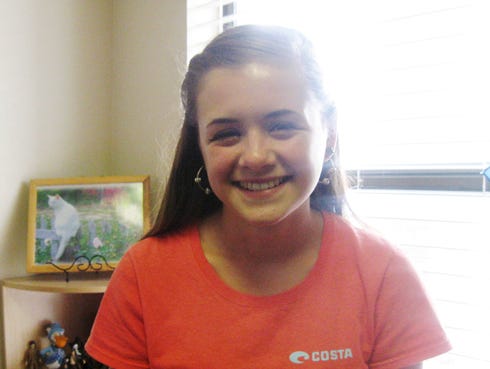
CRESTVIEW — Ever wonder why, on some nights, the gulf waters sparkle with glowing droplets when you splash in it?
Elizabeth Everett knows why.
“There’s a compound imbedded in the organism, when something moves it, it rocks those two components together and that produces luminescence,” Elizabeth said.
The rising Crestview High freshman took her interest in marine biology all the way to state competition in Lakeland, placing fourth in the 61st State Science and Engineering Fair of Florida in the Earth and Environmental Science category.
Her project, “A Glow in the Dark Phenomenon,” had won the regional science fair’s junior division earlier this spring, qualifying her for the March 29-31 state fair.
INTEREST PIQUED
Elizabeth traces her fascination with the lively and colorful world beneath the waves to a visit to the Georgia Aquarium when she was 7.
“When I saw that, I wanted to learn to scuba dive,” she said. “When I was 12, got my open-water diving license. When I’m 16, I want to get my advance open-water license.”
Once she had her scuba diving license, she returned to the place where her interest was first piqued.
“I went scuba diving in the Georgia Aquarium with the whale sharks,” Elizabeth said. “It was really cool!”
Deciding she wants to be a marine biologist, Elizabeth was poring through articles on the subject and came across one on bioluminescence, in which small organisms emit light.
“That got me really interested in it and I decided that’s what I was going to do this year,” she said.
With materials, including live organisms, ordered from a scientific supply company, Elizabeth recreated the conditions under which undersea critters glow. And she discovered how to make nature’s equivalent of a dimmer switch.
“When you decrease the concentration of nitrogen and phosphorous, the effects on dinoflagellates are less,” she explained. “When there’s an increase in those concentrations, there are visible changes. I could see the bioluminescence was brighter and there was growth in the test tube. The organisms were reproducing.”
NO ORGANISMS ALLOWED
Elizabeth’s award-winning report documented her research and showed photos and graphs from her experiment. But, she said, she wasn’t allowed to show off actual organisms at the fair.
“You’re not allowed to have the organisms with you, and besides, if I shook them to make them glow, you couldn’t see it because of the light in the room,” she said.
Ironically, despite her research and fascination with the topic, Elizabeth has yet to see the Gulf of Mexico when its local waters are aglow with bioluminescence. But that, she hopes, will change soon.
“I want to go night diving this summer or for my 15th birthday, Oct. 8,” she said. “I’ve watched documentaries about it, but I’ve never seen it in person yet, other than my experiment.”

This article originally appeared on Crestview News Bulletin: Davidson student's love of marine biology propels her at state science fair
